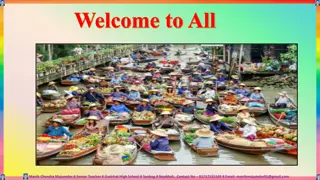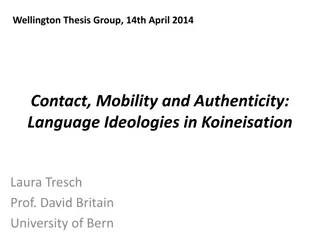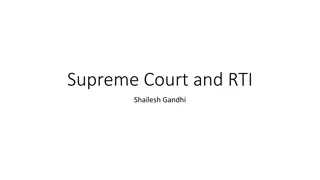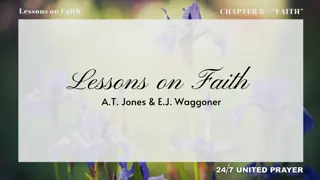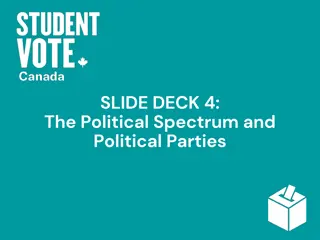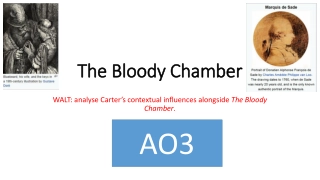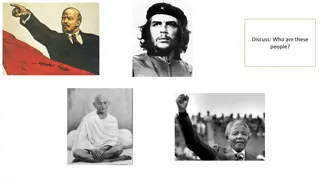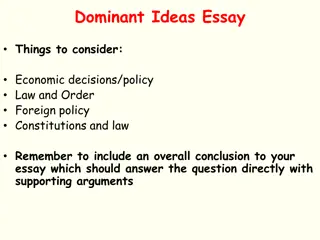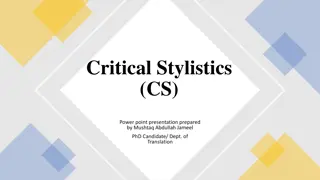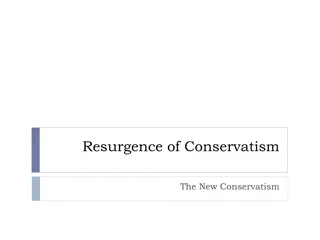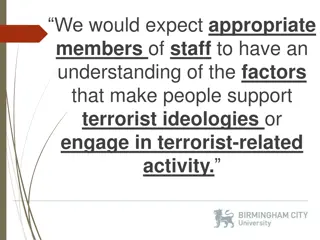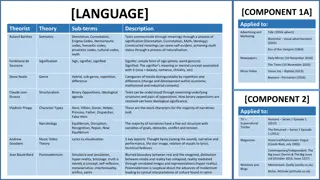Insights into Manik Bandopadhyay’s Works and Ideologies
Manik Bandopadhyay, an eminent Indian writer, delved into the complexities of human psyche and societal issues in his novels and short stories. Influenced by Marxist philosophy and Freudian principles, he portrayed ordinary individuals enduring extraordinary circumstances during the colonial era. His acclaimed works like "The Final Solution" depict the harsh realities faced by marginalized families post-partition. Bandopadhyay's narratives reflect on the absurdity of human existence and explore themes of suffering, cynicism, and decay of human values.
Download Presentation

Please find below an Image/Link to download the presentation.
The content on the website is provided AS IS for your information and personal use only. It may not be sold, licensed, or shared on other websites without obtaining consent from the author. Download presentation by click this link. If you encounter any issues during the download, it is possible that the publisher has removed the file from their server.
E N D
Presentation Transcript
DSE -PARTITION LITERATURE B.A. (Hons.) English VI Semester Dr. SHUBHA DWIVEDI ASSISTANT PROFESSOR DEPARTMENT OF ENGLISH ARSD COLLEGE
Manik Manik Bandopadhyay Bandopadhyay (1908 (1908- -1956) 1956) An Indian Writer, novelist, key figure in the development of 20thcentury Bengali Literature. His oeuvre comprises of 36 novels and nearly 250 short stories. His remarkable works are: Padma Nadir Majhi (The Boatman on the River Padma), Putul nacher Itikatha (The Puppet s Tale) Shahartali (Suburbia) and Chatushkone (The Quadrilateral) Bandopadhyay published 57 volumes during his lifetime. His stories and novels got published in the most prominent journals and literary magazines of the then Bengal including Bichitra, Anand Bazaar Patrika, Jugantor, Satyajug,Bangashree Noboshakti,Kalantar,Parichaya and many more. His life was marked by acute poverty and frequent illnesses. Worked as editor of Nabarun and Bangasree Manik Bandopadhyay tried to analyse the multi-dimensional facets of social reality. He also dwelt upon man s socio-psychological orientation and his consciousness. His fiction examines and investigates different problems confronting the social milieu.
He was inspired by Marxist philosophy and Freudian principles of psychoanalysis. Instead of describing the idyllic pleasures of life in rural milieu, he felt content to describe the psychic predilections and sinister workings of the human mind.The stories often unravel the dark, obscure, enigmatic aspects of the characters lives who often lead disturbed existence under the garb of seemingly unruffled and peaceful reality. He distinguished himself as a great novelist in the tradition of Bankimchandra, Rabindranath and Saratchandra. His fiction was about ordinary men and women who endured extraordinary circumstances during the independence era and his writings gave us a chance to revisit some of the most heroic yet forgotten characters of the times. As a novelist, he was concerned with change, the relation between cause and effect, crisis and resolution and was not merely content with recording or subjective analysis of historical events that influenced the individual in the context of colonial India.
The Final Solution The Final Solution The Final Solution is one of the most acclaimed works of Manik Bandopadhyay. The plot of the story revolves around an impoverished family that migrates to West Bengal after the partition of Bengal, turning them into distressed, homeless vagabonds,anonymous,nondescript among the strangers. The story brings out tales of suffering, molestation, rape and sexual violence quite common during the post partition days. The story evidently works on the helpless state of a young mother, Mallika who struggles to keep her self and her body unscathed in the face of the terrible events. The story unveils incidents of cynicism, defencelessness, decaying human values, spiritual desiccation, bringing out the absurdity of human existence.
The story documents and makes us perceive from close quarters, what Alok Bhalla calls, the note of utter bewilderment, the chaos,the insanity of the times when we fell out of a world of human world of languages,customs,rituals and prayers into a bestial world of hatred,rage,self-interest and frenzy. Displacement and dispossession are the crucial points of discussion in the narrative as Bandyopadhyay writes, Even a few days back, one could see the forlorn dispossessed people,spending their days and nights,huddled together like herds of cattle, and goats in the shelter of a railway platform.(p.36) Contrary to the popular androcentric male discourse on partition history, the story reaches the objective of feminist historiography in the words of Joan Wallach Scott as it makes women a focus of enquiry,a subject and an agent of the narrative. It also brings to the fore the massive disruption and crisis that followed partition and projects women as active agents rather than passive recipients of this change. The story captures women s experience of the partition which further delineates and reinterprets the significant turning point in history from the point of view of women, thus providing an alternate history where women figured not just as objects of study but as subjects and participants. The sexual abuse, defilement, dishonour, profanity, violation of dignity, transgression are questions that hit the readers hard in the course of the narrative.
Keywords: Displacement, dispossession, resettlement, home, labour, unemployment, hunger, starvation, labour, home, memories, communal violence, exploitation, realignment of family, community and national identities, refugee camps, rehabilitation, sexual assault, destitute, gendred social history, sexual transgression,prostitution In the opinion of Suranjan Das, a riot is a transformatory as well as historical event.It shapes and alters perceptions and aspirations. People are changed: their attitudes to each other and their ways of thinking about themselves are transformed. In the light of the above statement, one can easily apprehend the change that occurred in the lives of the people during partition and afterwards.
In the story, Manik Bandopadhyay distinctly recalls the overarching effects of the peace committee, rehabilitation programmes and the inhuman conditions of the refugee camps on the minds of the women survivors. The story epitomizes the struggle of a female protagonist against a depraved society;capitalist,hegemonic,androcentric and patriarchal to the core. The story recounts the economic deprivation and uncertainty for the lower classes in the immediate aftermath of partition. It also captures the ruthlessness, the intolerance and the manipulative nature of the exploiter-the moneylender or the capitalist. The story also observes the tendency among the oppressed to accept their oppressor as an inevitable evil of nature- A devil incarnate, with a vehement desire to own all making him a heartless and a diabolical person. The story makes subtle remarks on inconsistencies. The story is remarkable for the articulation of female subjectivity and for rejecting male protection/desecration upon women s body. Mallika s chooses prostitution to feed her little son compromising on her self respect and integrity. middle class hypocrisies and
Mallikas husband is a diminutive figure, turns out to be an abject failure, a feminization of her counterpart,incapacitated and unable to sustain his family. Mallika s decision to choose prostitution as a means to feed her little son comes as a last resort to be able to fend for her son and family when all doors to finding suitable employment get closed and she finds her family standing on the verge of death owing to starvation. Her opting for prostitution as a way to salvage her family from sinking and perishing accentuates her maternal instincts in defiance of her constant humiliation by Pramatha. She is a figure of courage as she thwarts Pramatha s plan to exploit her and other women in their state of helplessness and daringly impedes Pramatha s advances towards her by strangling him to death. He final revenge brings an apt closure to the tale of misfortunes heaped on innocent,gullible female victims by spiteful,stony-hearted racketeer. Mallika s courage in the face of adversities wins the hearts of readers as she stays undaunted by the final catastrophe and reaches the final solution through her strong will and presence of mind.
In the opinion of Sukanya Choudhury, Mallikas revolutionary stance symbolizes an anti hegemonic bodyscape to reterritorialize her identity. In her retributive action lies her courage to question the dominant forces of the society, she blurts out in rage: ...I ve found an excellent way out. That gangster! He thought he had got me to carry on his infamous goings on. What did he take me for? Am I physically weak because I m a woman?(p.46) Mallika has a strong sense of self and bravely subverts the gender centric norms by deciding to earn for her family. In her case mothering results in slow forgetting of the self. Yet, she never gives up even when she is overwhelmed by anxiety and anguish. In the end, she gains full control over the inner struggle and the outer struggle. The story documents women s response to the cataclysmic episode of Partition: sometimes with their wilful amnesia of the violation, the appropriation of male roles as breadwinners, as anchors to the family in the state of helplessness, transgression to sustain their family from the state of abject poverty and adopting changing gender roles and attributes as they flaunt courage, practicality and patience in the extremely intolerant times. Quite appropriately, the story stands as a reflection of microcosm in a macrocosm. Partition was surely just a political divide or a division of properties, of assets and liabilities. It was also, to use a phrase that survivors use repeatedly,a division of hearts. (Urvashi Butalia)
Confronted with violence, Mallika turns out to be a heroic figure in the end who doesn't give up in the face of calamities,in her case brought by devilish capitalist forces hell bent to dispossess and degrade her identity. The final act of retribution should be seen as the possible alternative to the disorder in the absence of the normal moral/social order. The ending evokes a sense of shock and bewilderment but has a plausible justification despite its unnaturalness and unexpectedness. In the end, her calm and composed response puts to rest all misgivings about the appropriateness of her conduct. Have you all eaten?... We ll never be hungry again, Thakurjhi never, ever... My son will have milk four times a day. .. I ll go to the railway station every evening in my frayed sari, the sharks will come to pick me up for sure... ...But this time I ll be carrying a sharp knife with me , you understandThakurjhi (p.46)
References References Menon, Ritu and Kamla Bhasin. Speaking for Themselves: Partition History, Women s History, Partition Literature: An Anthology, ed.By Debjani Sengupta.Delhi:Worldview,2018. Mookerjea, Debali. Literature, Gender and the Trauma Of Partition. London& NewYork:Routledge,2017. Mishra, Gauri. Gender and partition. Women And Empowerment in Contemporary India. Ed.Brati Biswas et al.Delhi:Worldview,2016. Butalia, Urvashi. The Other Side of Silence. New Delhi: Penguin,1988 Butalia, Urvashi. The Other Side of Silence. New Delhi: Penguin,1988 Kumar, P Sukrita. Narrating Partition: texts, Interpretations, Ideas. Indialog publications,2004.


